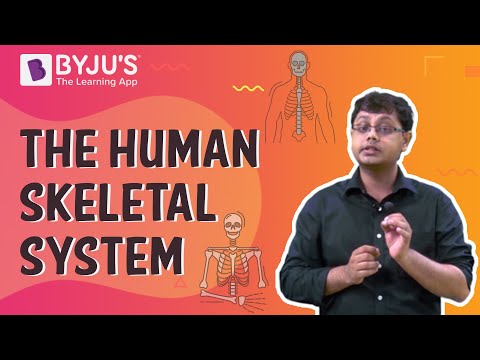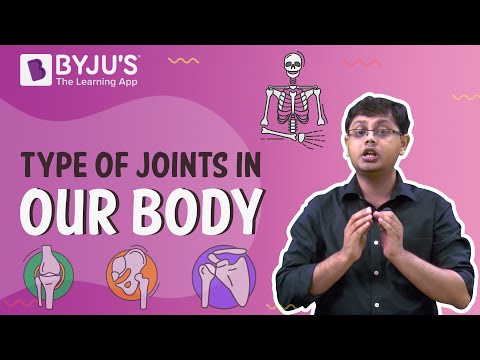According to the CBSE Syllabus 2023-24, this chapter has been renumbered as Chapter 5.
Introduction to Body Movements
Movements
The ability of organisms to change position by using their body parts is called movement.
To know more about Movements, visit the link below;
Skeletal System
Skeleton
- A skeleton is an internal structure in organisms which helps in bringing about movement.
- It forms a framework that gives the shape of the body and provides support to organisms.
- The skeleton is made up of bones.
- Different kinds of bones are joined to each other in a particular manner.
- These joints facilitate various types of movements.
- In higher animals, bones, muscles and cartilage together make the movement possible.
Muscles
- Muscles are parts of the body that help in bringing about movement.
- Muscles may be attached to bones (humans) or may work alone (earthworms).
Cartilage
- Part of the skeleton that is not hard as bones and can be bent is cartilage.
- They are found in the upper part of the ear, the tip of the nose and at the tips of long bones.
For more information on The Human Skeletal System, watch the below video

To know more about Skeletal System, visit the links below;
Joints
- Joints are the points where two parts of the skeleton are fitted together to make movement possible.
- Examples are the hip joint, elbow joint, knee joint, etc
Ball and Socket Joint
- Ball and socket joint, where the rounded end of one bone fits into the cavity of the other bone.
- It brings movement in all directions.
- It is seen in the hips and shoulders of the human body.

Pivot Joint
- A pivotal joint is where a cylindrical bone rotates in a ring.
- It joins the neck to the head.
- It allows us to bend the head forward and backwards and turn the head to our left or right.

Hinge Joints
- Hinge joints bring about movement in only back and forth direction.
- The knees and elbows have hinge joints.
- The following image is a hinge joint in the elbow.

Fixed Joints
- Fixed joints are immovable joints because the bones are joined together.
- Such joints are found in the skull.
For more information on Types of Joints in the Human Body, watch the below video

To know more about Types of Joints, visit the link below;
Gaits of Animals
The different patterns of movement of animals due to the differences in their skeletal structure are called gaits of animals.
Earthworm
- The earthworm does not have any internal skeleton.
- The body is made up of many rings joined end to end, and muscles attached to these rings help to extend and shorten the body.
- The skin of earthworms also has a large number of tiny bristles that help them get a good grip on the ground.
- Repeated extension and contraction of the body muscles enable the earthworm to move through the soil.
Snail
- Snails move with the help of their muscular, flat foot.
- They glide along a solid surface which is lubricated with mucus.
- This motion is powered by succeeding waves of muscular contractions of the foot.
Cockroach
- The body of a cockroach is covered with a hard outer skeleton that is made of different units joined together.
- It has three pairs of legs for walking and two pairs of wings attached to the breast for flying.
- It has distinct muscles that are used for movement.
- The muscles attached to the legs help in walking.
- The breast muscles attached to the wings help in flying, although they are not good flyers.
Birds
- Birds have special skeletal and muscular structures that help them to fly.
- The forelimbs are modified to become wings, and the bones inside are hollow to suit flying.
- The bones of the hind limbs are used for perching and walking.
- The shoulder bones and breastbones are strong and support muscles of flight, which move the wings up and down.
Fish
- Fishes have streamlined body that helps them swim with the least resistance.
- They use their tail fin for small jerks through water, and other fins assist swimming.
- The tail fin is also used for changing directions.
Snakes
- Snakes do not have legs for movement but use their long backbone along with muscles for movement.
- Their body curves into many loops, which gives them a forward push by pressing against the ground.

To know more about the Gait of Animals, visit the link below;
Learn more about the movements of the body, bones, joints, and about the skeletal system from the topics given below:
| Joints | Locomotion |
| Types Of Joints | Skeletal Muscle |
Frequently Asked Questions on CBSE Class 6 Science Notes Chapter 8 Body Movements
What are the different parts of a human skeleton?
The human skeletal system includes the skull, vertebral column, collarbone, shoulder blades, rib cage, pelvic girdle and the bones of the hands, arms, feet and legs.
What are the different types of joints?
Functionally the three types of joints are synarthrosis (immovable), amphiarthrosis (slightly moveable) and diarthrosis (freely moveable)
What are the uses of the pivot joints?
A pivot joint allows movement in one plane, such as rotation about an axis.
Comments